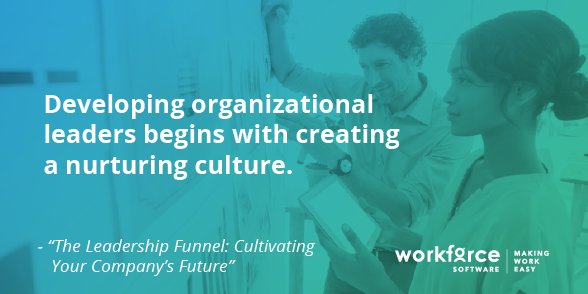This article was originally published on The WorkForce Blog.
What do high employee engagement rates, long-term customer loyalty, and positive brand perception have in common?
They’re all the product of stellar leadership.
Leadership that guides staff through periods of doubt and uncertainty. Leadership that encourages people to take risks, make mistakes, and fail forward. Leadership that leaves the office door open.
In today’s increasingly intricate and involved workplaces …
Solid leadership is more important than ever.
But it’s also more challenging than ever to provide.
According to a global trends study by Deloitte, the challenges facing leaders are stacking up: Ever-evolving technology; multi-generational workforces; remote employees. These and dozens of other new-age factors add to the already complex task of managing a team.
That said, there’s one challenge capable of disrupting not only a team or department, but the future of an entire organization: The leadership funnel.
Deloitte’s report cites that leadership pipelines are growing top-heavy. In other words, future managers—people who carry the inherent qualities and traits of capable leaders—simply aren’t being developed.
How to cultivate your organization’s future:
Developing organizational leaders begins with creating a nurturing culture. A culture that provides a foundation for young, talented employees to find their footing, their confidence, and their calling.
This culture is built on the backs of existing managers and directors, executives and board members who consistently make it a point to:
1. Talk.
Clear, honest communication is the bedrock of professional development.
Of course, this is a two-way street: Managers should constantly provide immediate, honest feedback while employees should feel safe and comfortable speaking up about whatever, whenever.
2. Bend.
People who work in a flexible environment—in a culture that’s open to challenging the status quo—are more confident, creative, and innovative.
Of course, giving employees a degree of autonomy over their approach and decisions enables more than a fresh perspective and new ideas. It also makes it easier to spot gifted people who have what it takes to lead others.
3. Push.
Growth takes place outside of familiarity, away from comfort.
A culture that pushes employees to try, fail, learn, and rally has the potential to inspire profound confidence in people. Confidence, then, can spell the difference between ambition and apathy, progress and stagnation, leadership and incapacity.
4. Acknowledge.
People perform for money, but they go the extra mile for recognition.
An organization that encourages managers to credit high-achievers—to praise and recognize people for thoughtful, progressive work—is promoting an eager, dynamic culture. A culture where talent and potential makes itself known.
5. Ask.
If you’re not sure what your people want (or need) from a cultural standpoint, just ask. They’ll tell you.
But you have to go about it the right way.
Your culture is your future.
Where there is potential for growth, there’s talent.
As long as you’re cultivating a culture that supports and enables the development of future managers—that gradually draws young talent through the leadership funnel—you’re setting up your organization for innovation, growth, and success.




